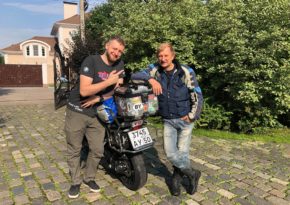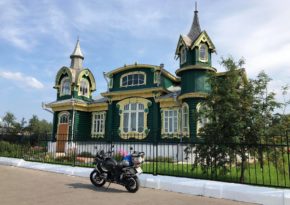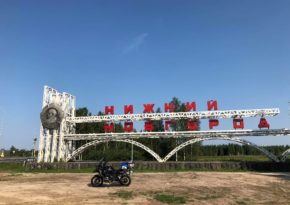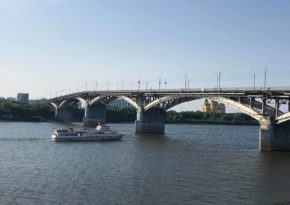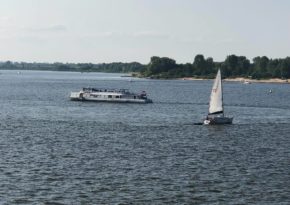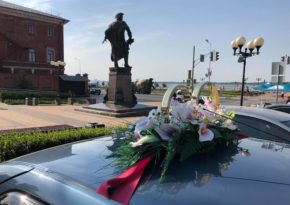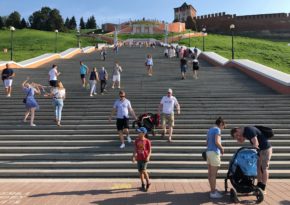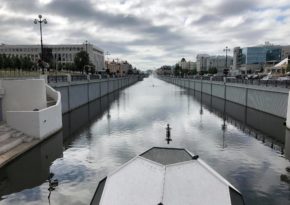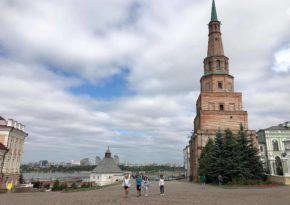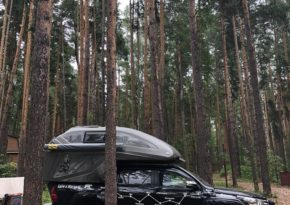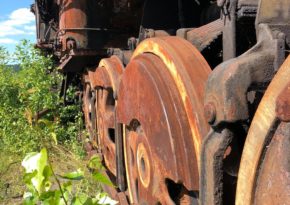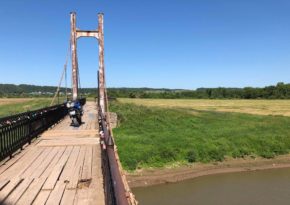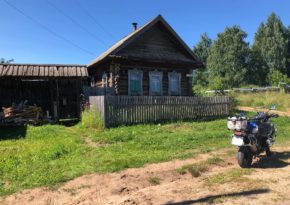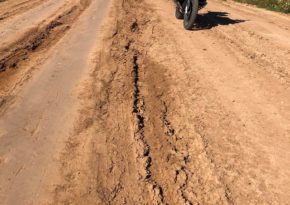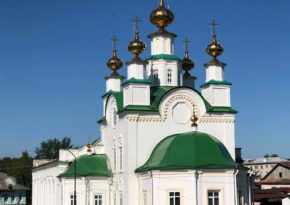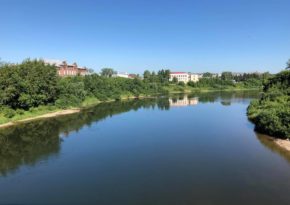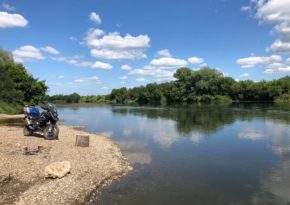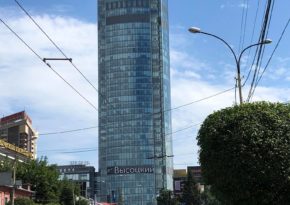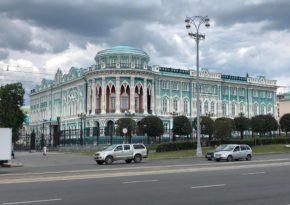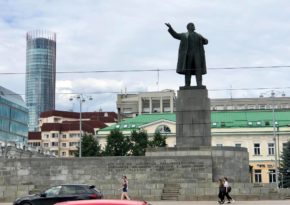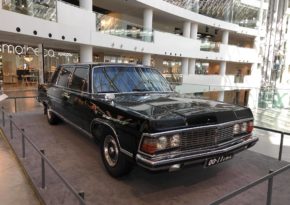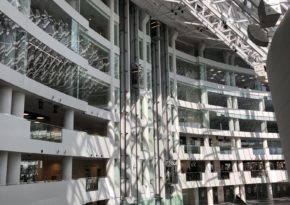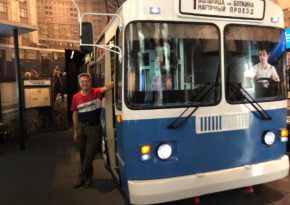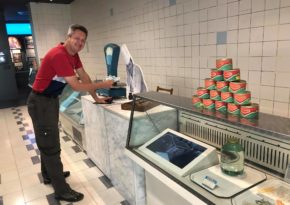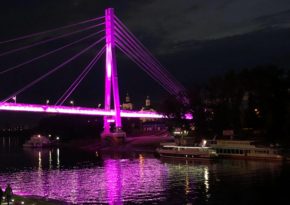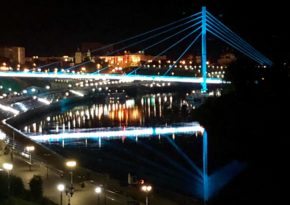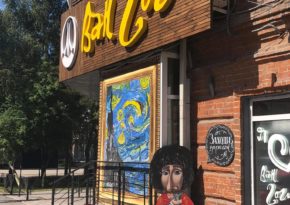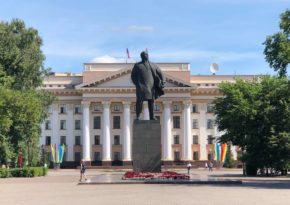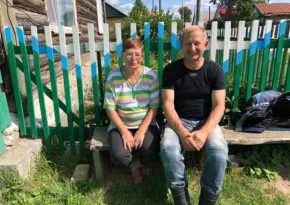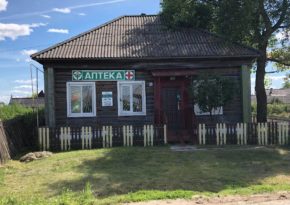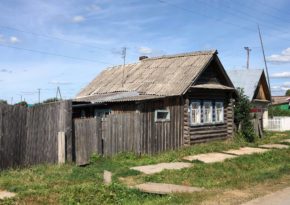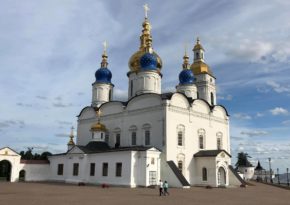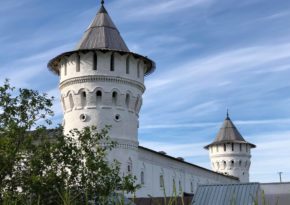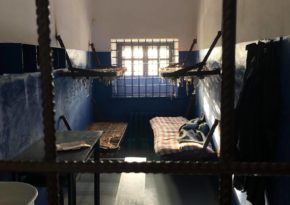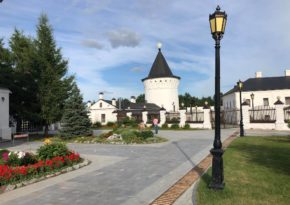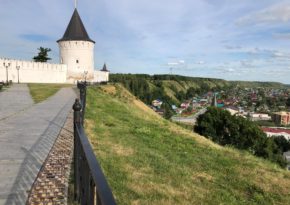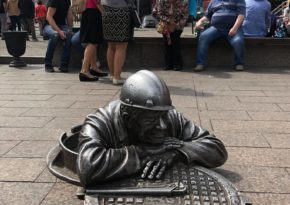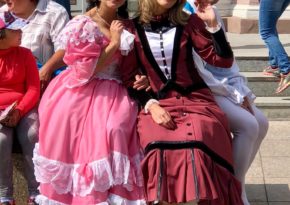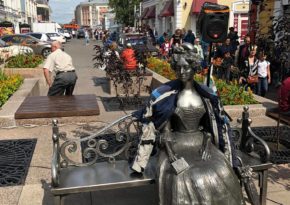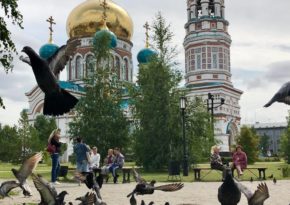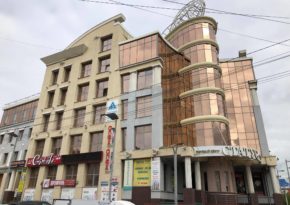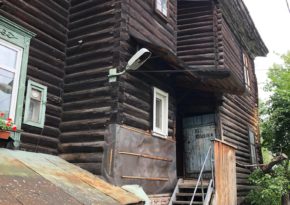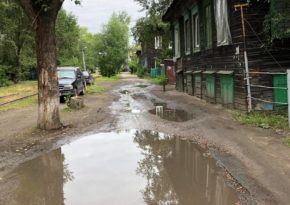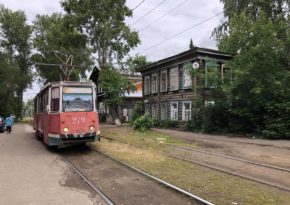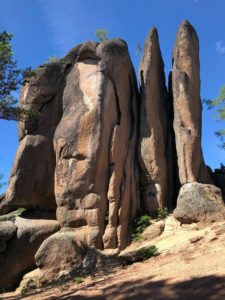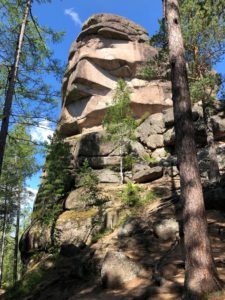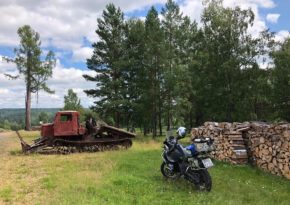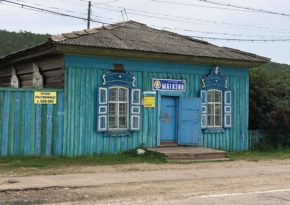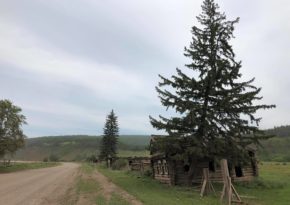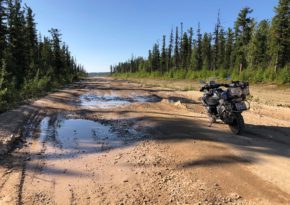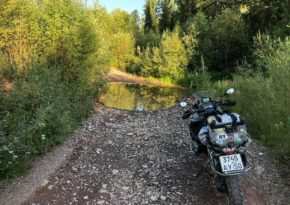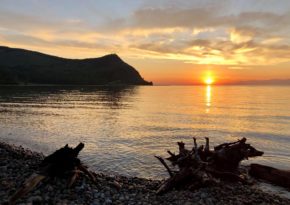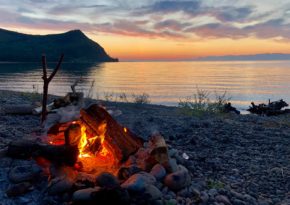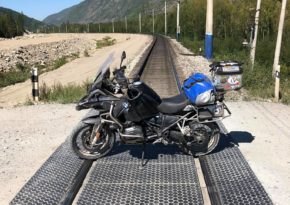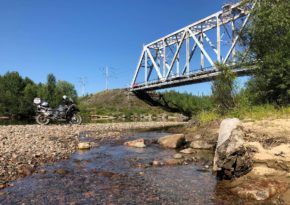Heading for Magadan: Podolsk → The Ural mountains → Siberia
Let's go...
It took us several hours to get out of the stuffy embrace of Moscow. Oleg was especially unlucky. Having set off from Podolsk on Friday, he crawled only 120 km by Toyota with a trailer in six hours! And I had been squeezing on my motorbikey between the cars and dusting on the roadside all the way to town Vladimir on Saturday. The temperature was +32°C! There was only one desire in my head. I looked forward to getting as far as possible: across the Urals, to Siberia, to the bears, where there are no cars and no people who live like in a huge hive.
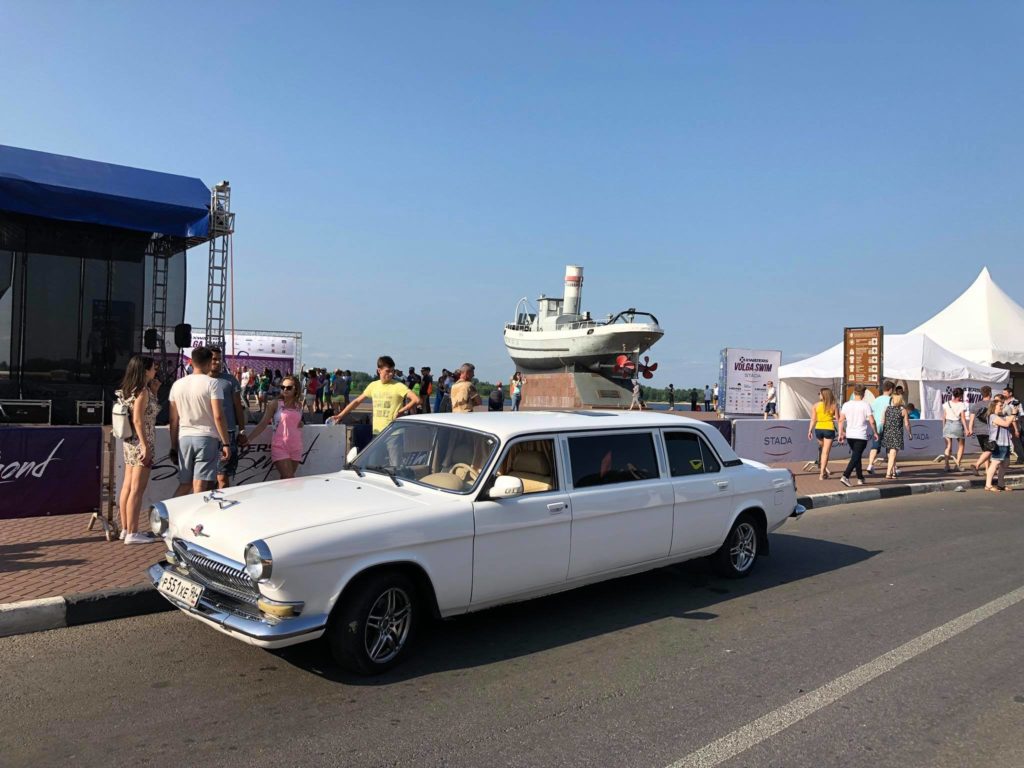
After lunch I was already walking along the endless embankment of the Volga in Nizhny Novgorod and watching the newlyweds descending the wide and tall stairs, leading to the Kremlin. From time to time they were posing in a romantic way to take a picture.
There are 400 km between Nizhny Novgorod and Kazan. The first half of this path is mostly one lane with an endless solid dividing line. And I saw so many trucks following one by one.
Kazan greeted me with a nighttime fireworks display and a fabulous Kremlin with gorgeous lighting in the background!
In the city centre I met Oleg and my friend Andrey Zaitsev, who sincerely welcomed us in his lovely wooden house (which was in the pine forest 25 km from Kazan).
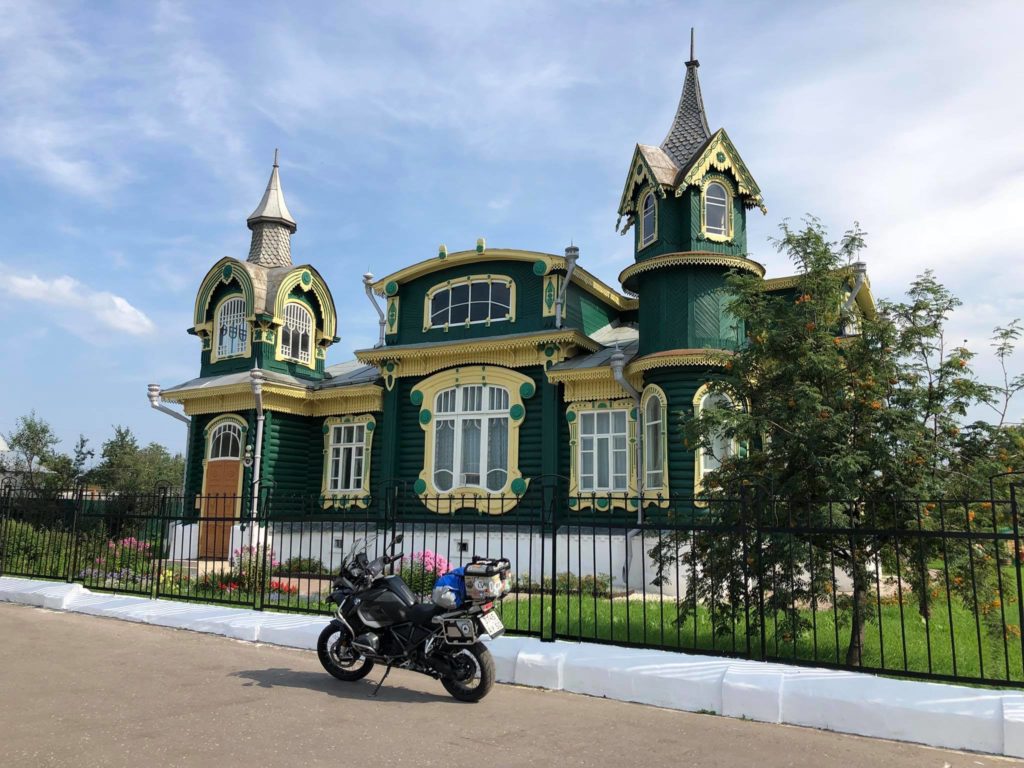
I had last visited Kazan about ten years before. It had been an awful, dirty and devastated city, full of gangsters. Today the capital of Tatarstan has changed drastically! Since the Universiade and the World Cup were held there, everything had been rebuilt, restored and decorated. Now in Kazan you can see wide avenues, streets in flowers and a snow-white Kremlin with blue mosque domes and pointed minarets.
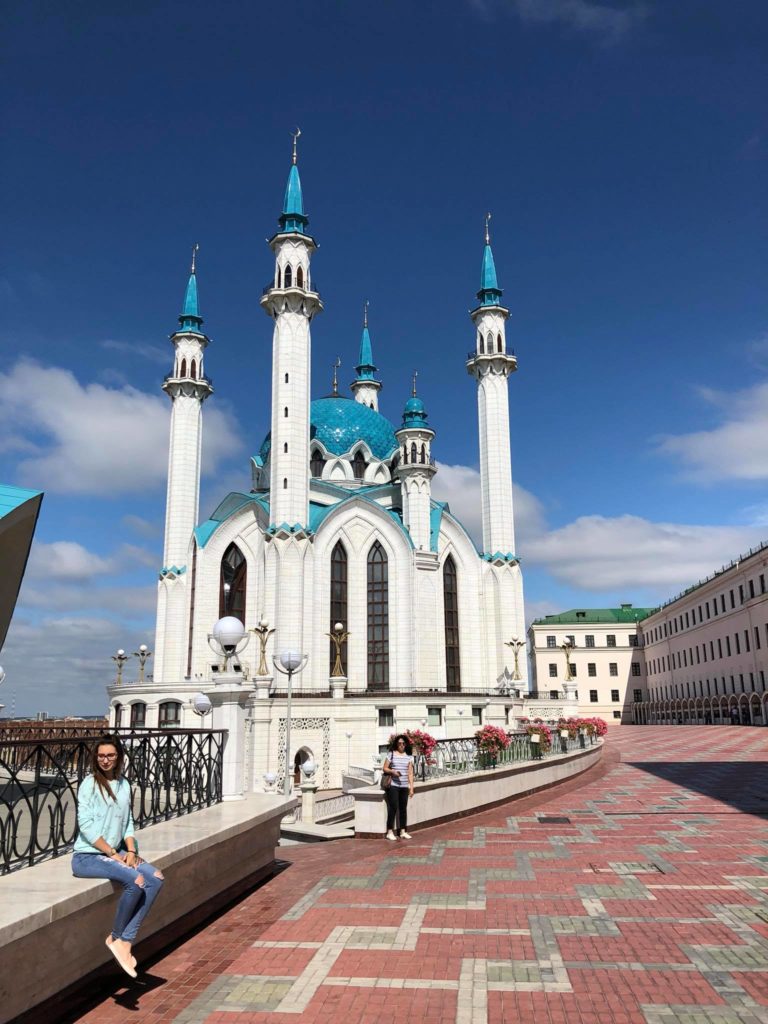
The viewpoint of the Kremlin offers a beautiful sight of the city and the Kazanka river. An outstanding bridge with supports in the shape of M-letter and a TV tower, shimmering with all the colours of the rainbow, will remain in my memory as unique symbols of Kazan.

After lunch we went on an excursion to the island town named Sviyazhsk, which had been founded by Ivan the Terrible as an outpost for the subsequent capture of Kazan in 1552.
This is a very interesting place from a historical, architectural and geographical point.
I did like Kazan! Andrey Zaitsev, thank you for a kind-hearted welcoming, gorgeous sauna and informative excursions!
And now we are going further east to the Perm Region!
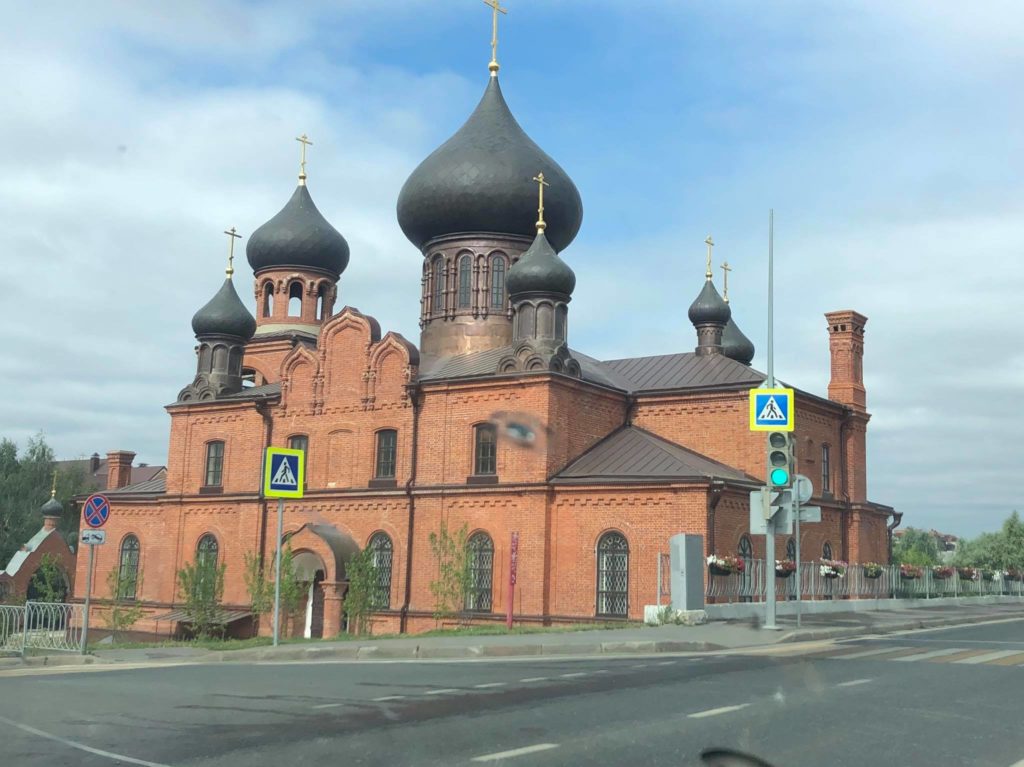
One of the undeniable advantages of solo travelling is the opportunity to easily make conversations with strangers. If possible, I am always ready to communicate with someone and often a random small talk gives a lot more understanding of how people live in a particular area than the information from other sources may give.
Having ridden a couple of hundred kilometers from Kazan, I made a stop in the central street of an ordinary and unremarkable Tatar village with an incomprehensible name "Staraya Salous". While I was checking my navigator, a 60-year-old man came up to me. He had an unopened bottle of vodka in his hands, but looked quite sober. He asked me where I was going and if I needed any help. Well, you can find out what happened next by watching this video :)
I came across a description of this place on the Internet by chance (and there I also found out the coordinates). And now I'm following the route of my navigator along the field and the ground roads to the village Spaso-Barda, which is a hundred kilometers from Perm, if you go along the E-22 highway in the direction of Yekaterinburg.

I crossed the Silva river over the bridge and then rode straight along the sleepers of an abandoned railway for a few kilometers. Finally, I reached a field overgrown with young birches, which was located between the river and the forest. There I saw the brown carcasses of the iron monsters.
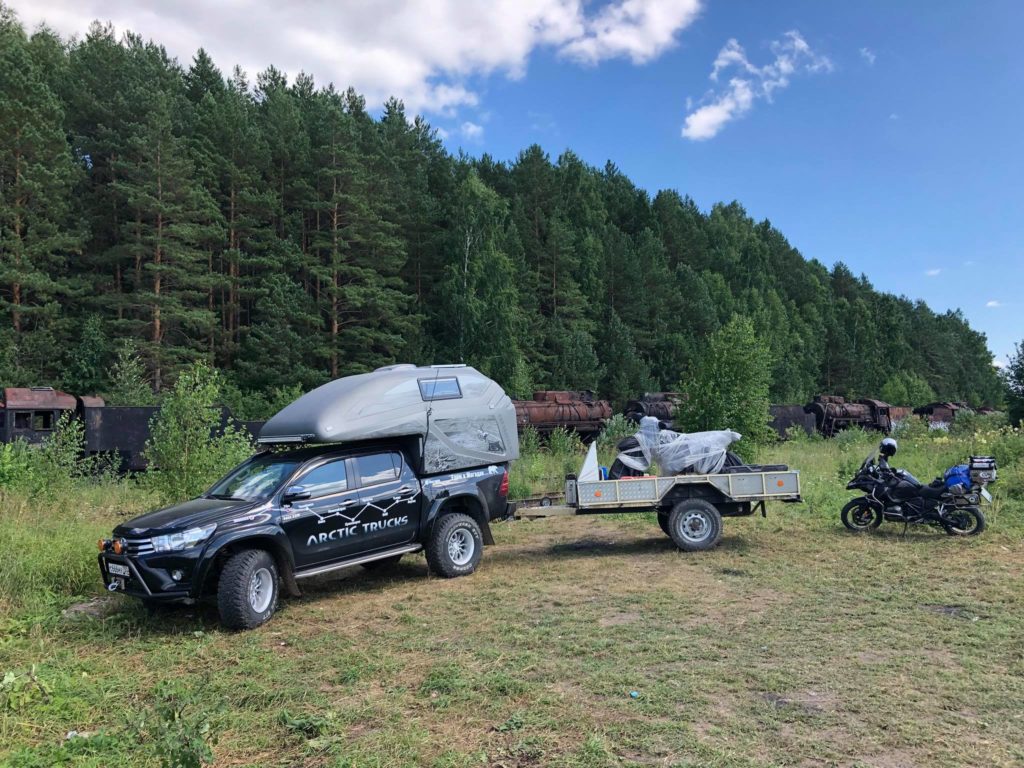
These are huge monsters that are similar to prehistoric dinosaurs, lined up in a row on the rotten tracks with rusty rails.
They are steam trains.
There were dozens of them in the field. Half-looted and taken to one place to be buried, these trains still look respectable. Some of them have stars or stamps of the 40-50s on the front of the hull. There were also inscriptions of their belonging to a particular railway. These steam trains are the silent witnesses, which participated in the great events of the last century.
I climbed the metal ladder into the cabin and sat in the machinist's seat next to the window.
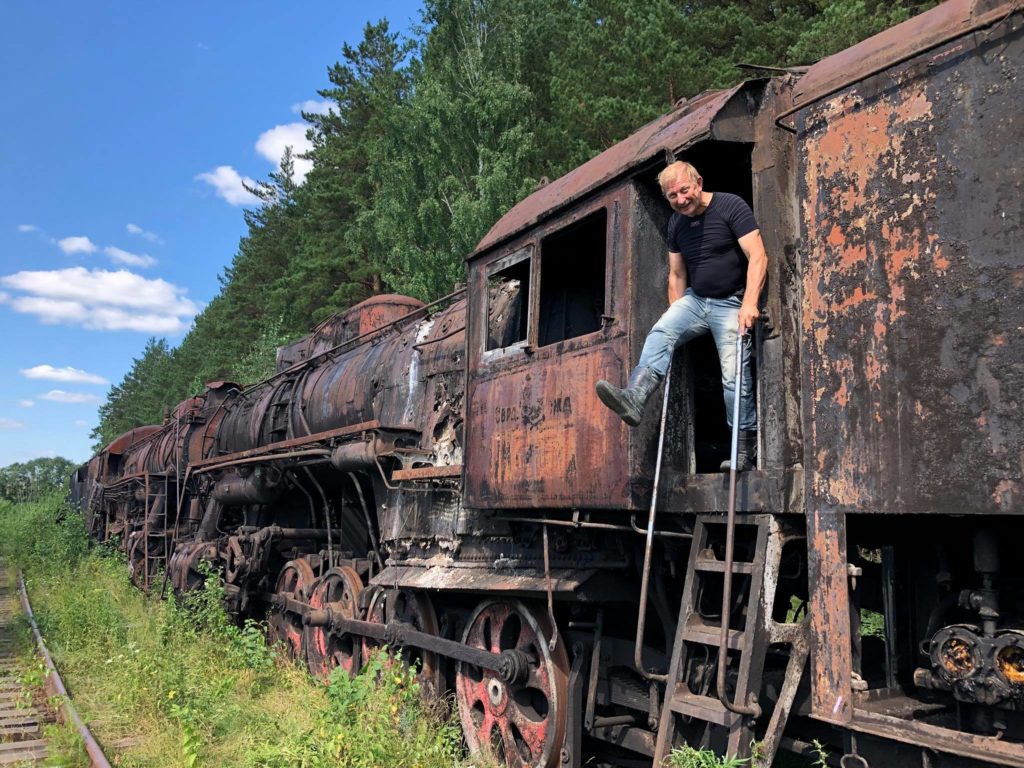
On the bottom of the cab on the left there is an open flap, which shows a black mouth of a huge boiler that might have consumed more than one thousand tons of coal during its life. Do you remember the old movies, in which the machinist's assistant throws coal right into the furnace with a huge shovel? And this one is a more modernised model: here the coal was supplied by means of a screw through a pipe from a huge cone-shaped tank placed behind the cabin. There was a metal handle above me (apparently, the handle served for opening the valve of a train horn). And everywhere there were valves, pipes and so on… Everything was black, sooty, covered with coal dust and oil. I looked out of the window and imagined how I would give a signal and steam clouds would break out to the sides, powerful levers would start spinning huge cast-iron wheels and the steam train would slowly start picking up speed.

The lyrics of the old revolutionary march came to my head: "Our train flies forward, next stop - in The Commune!"
However, we haven't reached the "bright future".
Perhaps, it isn't our fate.
Anyway, thank heavens.
My journey across Russia continues. There are six regions and two republics left behind. We reached the Urals. There is Siberia and the Russian Far East ahead (these areas take up half of the country). The weather is perfect for a motorbike trip and my mood is great!
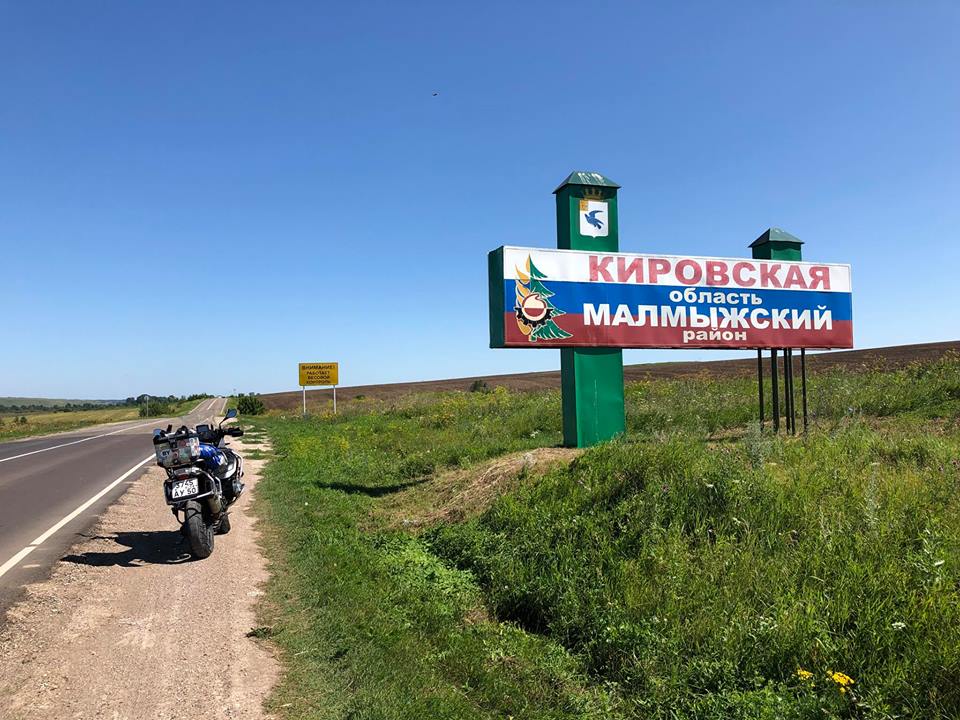
Russia never ceases to amaze us with its scope, diversity of nature and wonderful people that we meet on our way!
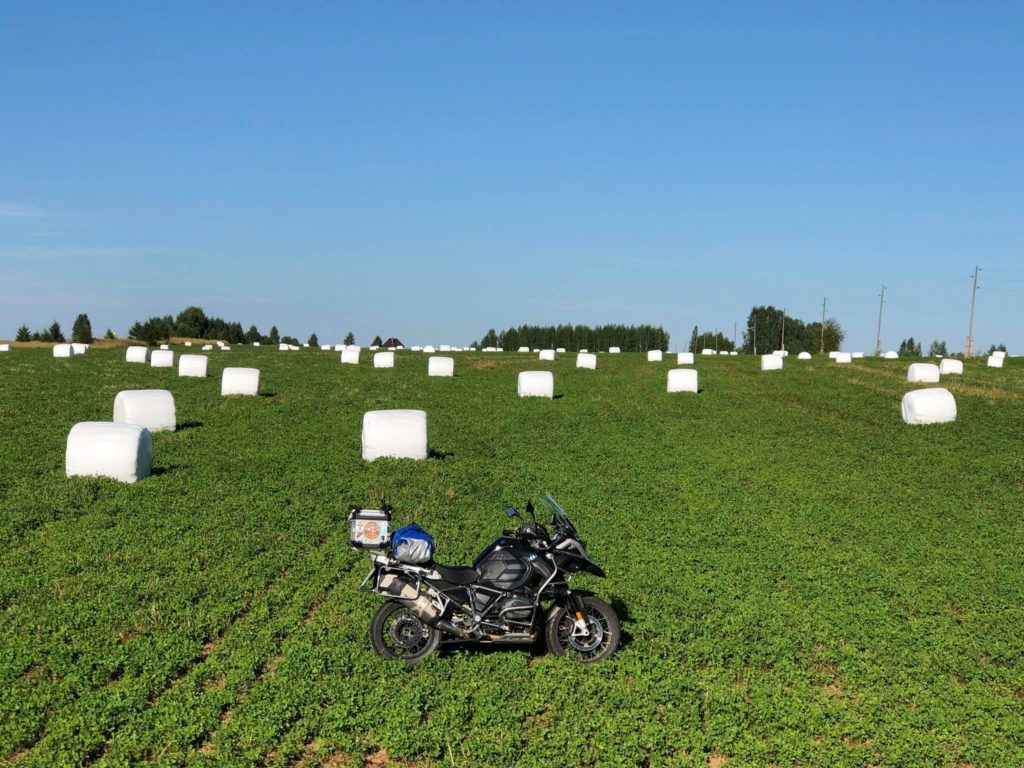 \
\
Today we keep going east. There is Tyumen ahead!
Heading for Magadan.
Ekaterinburg.
Having passed through the virtual border of Europe and Asia, we continued our journey across Siberia.
Yekaterinburg made the impression of a fairly decent metropolis with wide avenues, modern high-rise buildings, shopping malls and entertainment centres, excellent roads and green streets.
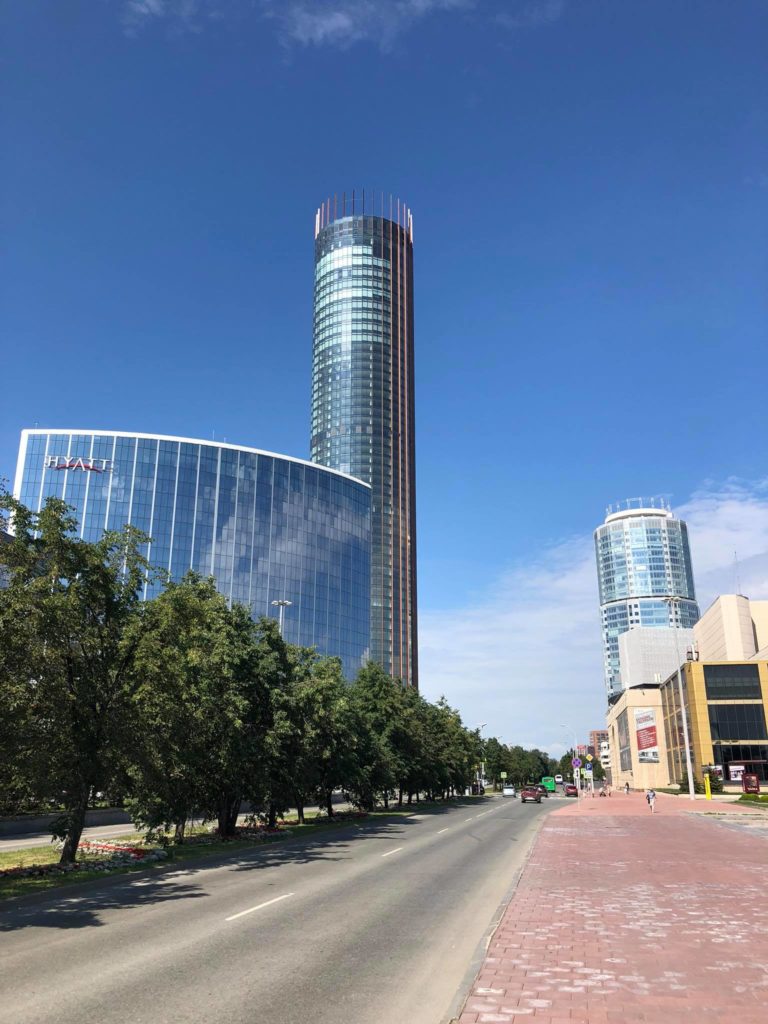
The economic centre of the Ural region and the fourth largest city in Russia looks very decent. While walking around the central part of the city, we went to the Yeltsin Centre. It is a beautiful modern building made of glass and concrete, in which there is a fitness centre, a café, cinemas and other entertainment venues.
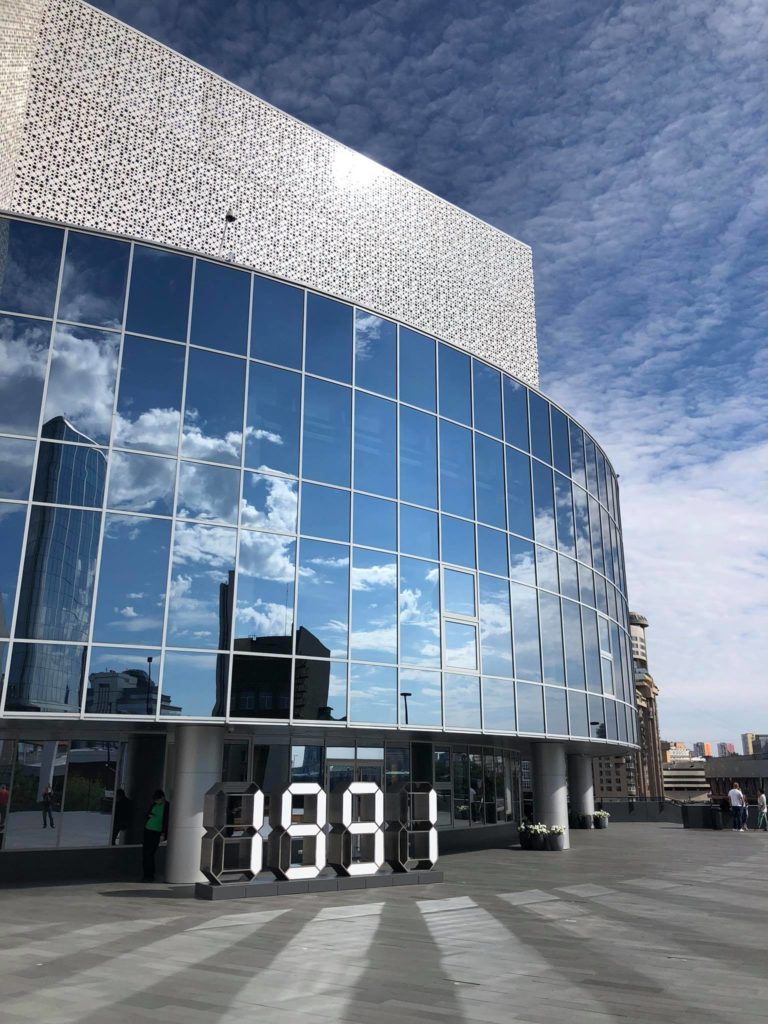
We were interested in the Boris Yeltsin museum most. If you happen to be in Ekaterinburg, you should visit this place. This professionally designed exposition occupies a huge space.
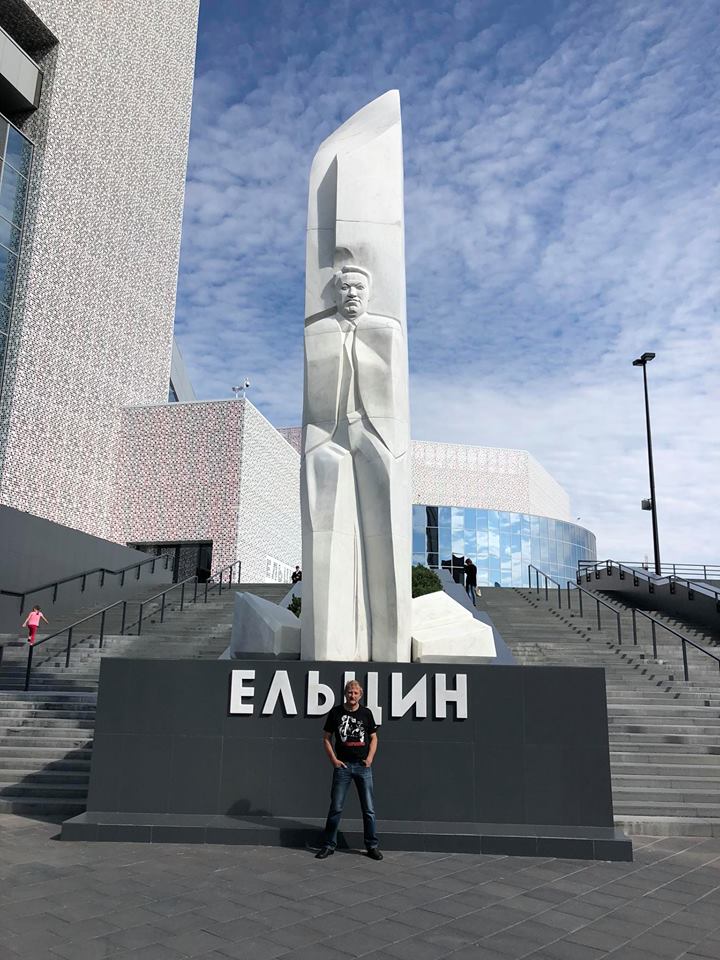
While you're walking the halls one by one, you will immerse into the history of Russia. There are a lot of authentic exhibits of the Soviet period. The main idea of this museum is to show the visitors the historical and revolutionary comrade Yeltsin's contribution to the creation of a democratic and free Russia, which threw off the shackles of autocracy and totalitarianism of the Soviet period for the first time in its thousand-year history.
And we all should be grateful for this freedom to the first President of the Russian Federation, Boris Yeltsin. That's exactly the impression that the museum is supposed to make on you (of course, only if you don't remember what the country was like in the 90s because you're young or generally had little interest in contemporary history). But if you don't have much time, it's better to go to a small but very nice museum devoted to Vladimir Vysotsky. It's placed in the tallest tower of Yekaterinburg, which is called the Vysotsky skyscraper. In addition, you can go up to an observation deck on the 53rd floor and see the city from a bird's-eye view! It's enchanting!
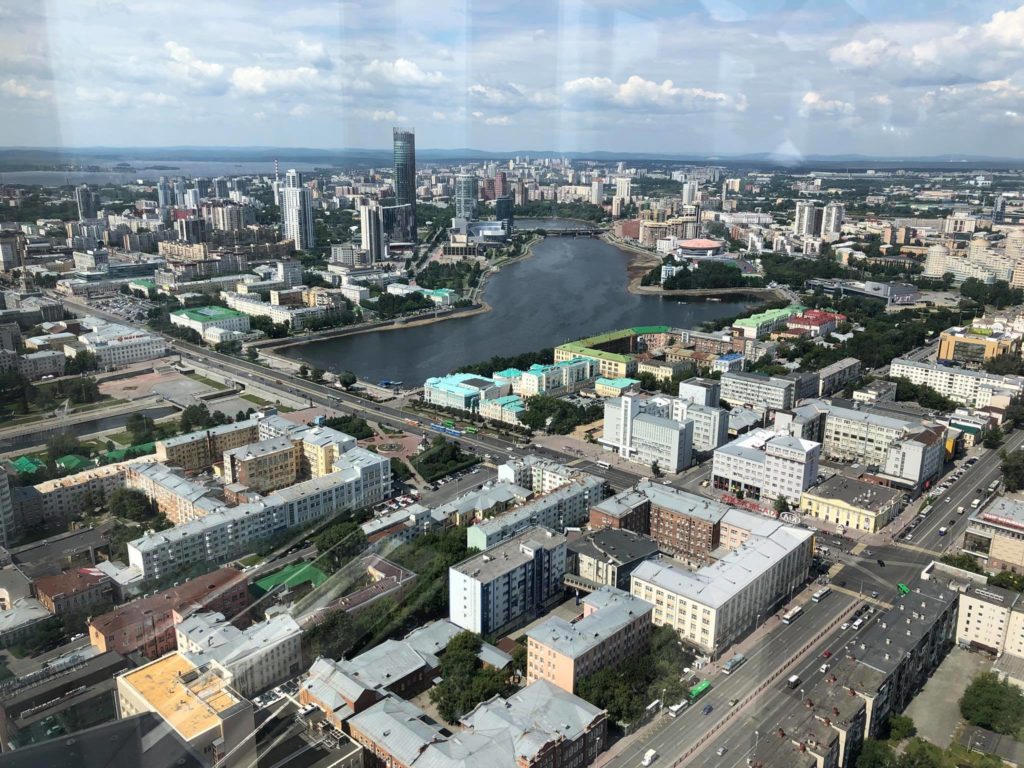
Heading for Magadan.
Tyumen.
The Yekaterinburg-Tyumen highway turned out to be jammed. I was riding along it like in the Moscow suburbs on Friday afternoon. I was overtaking, then braking, then waiting for the interval on the oncoming lane… then overtaking and braking again for all the 350 km.
I arrived in Tyumen in the evening, waited for Oleg and we immediately headed for walking around the city. We went down to the embankment of the river Tura and were stunned! I have never seen such a beautiful embankment in any European city! The high bank of the river is lined with granite and marble in several tiers! There are gorgeous flower beds, perfect lawns, beautiful illumination, fountains, benches, cafés and stalls with ice cream and pastries. And everything is so tidy! Have a look at the cable-stayed bridge across the Tura, which shimmers with all the colours of the rainbow. That's just fantastic!
In the morning we had a further exploration of the central part of Tyumen and our impression left from the evening walk was even strengthened. Tyumen is a beautiful and comfortable city, full of greenery, wide sidewalks, bike paths and restored wooden log houses placed side by side with modern buildings.
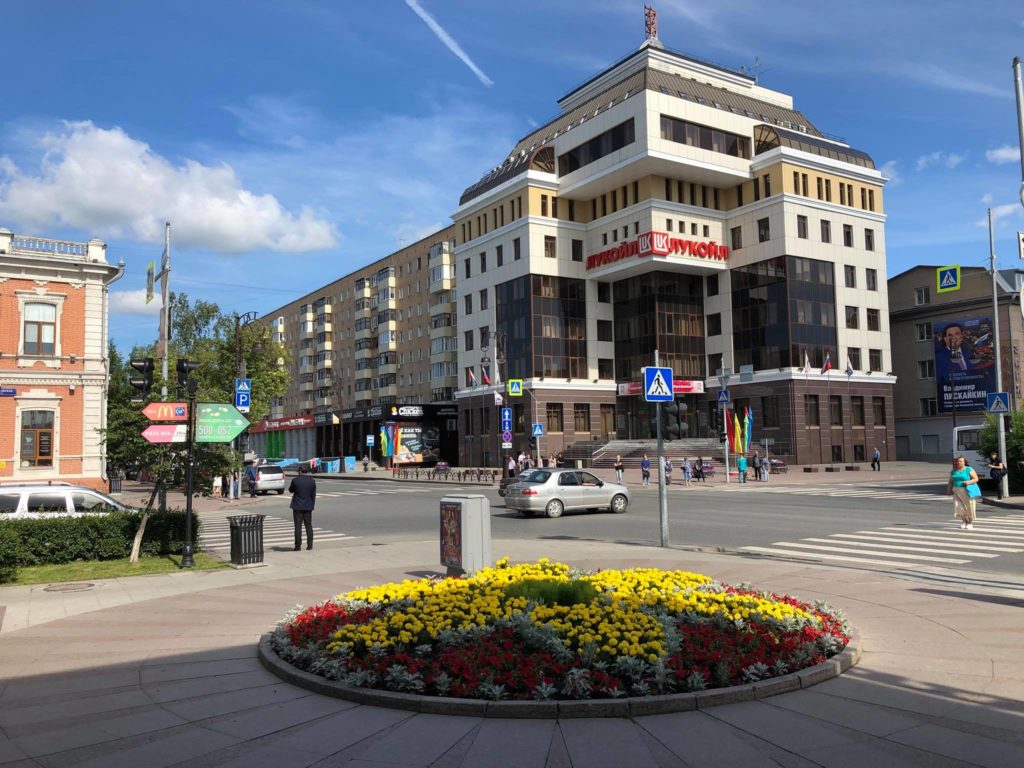
In one street we occasionally met a local resident, who introduced himself as Alexander.
He appeared to be a very good storyteller and told us the history of Tyumen from its foundation to nowadays in a simple and warm hearted way. Actually, Tyumen used to be a small dirty backwater town, however, it flourished in the early 2000s, when a new mayor came to power. It was Sobyanin, who is the mayor of Moscow now.
That's why there are so many wide sidewalks, tiled lawns and parks in addition to the wonderful granite embankment.
Heading for Magadan.
If you go along the ideal P-404 highway to Tobolsk, then 70 km from Tyumen there is a village with a typical for Russia name, Pokrovskoye.It's an ordinary and unremarkable village in the Siberian hinterland. There are thousands such villages in Russia, but this one is distinguished by the fact that Grigory Rasputin lived here. He was a well-known controversial personality and left a noticeable trace in the history of Russia.
About 1500 people live in the village. The central street is paved, there is a school, a shop, a house of culture. Houses are provided with gas and running water. There are tractors "Belarus", ZIL or UAZ parked near almost every building. We saw many beautiful log houses as well as the old and crooked ones.
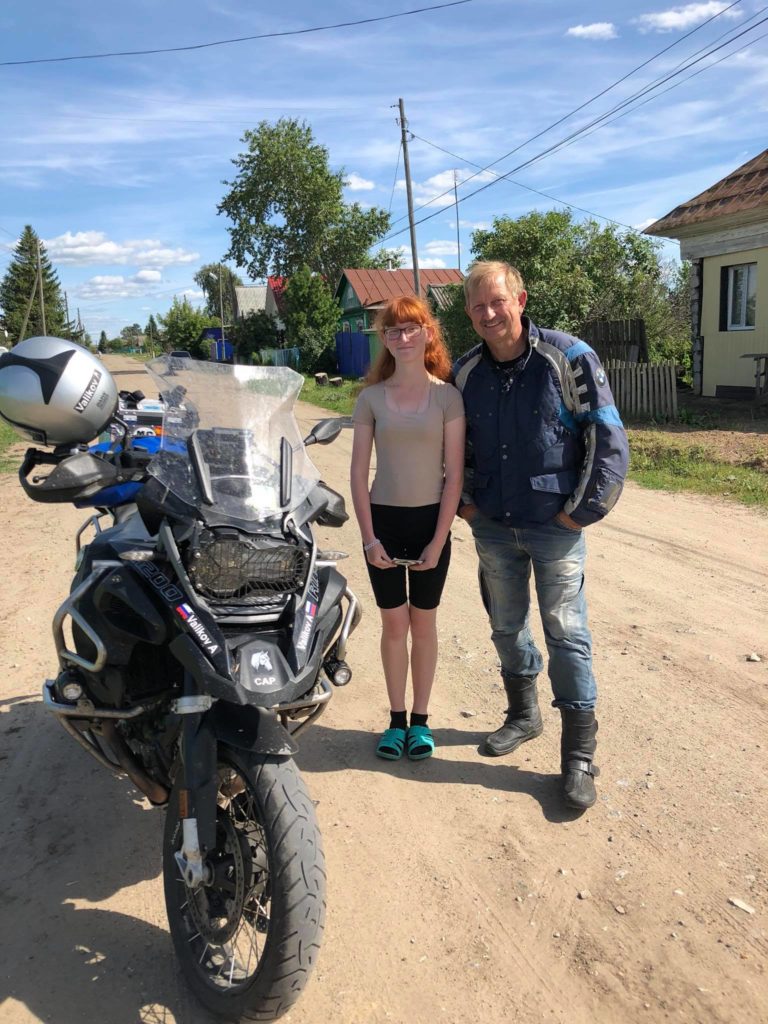
Having spoken with local residents, I was surprised to find out that houses are not cheap there. An average small house with a yard of 15…20 acres costs 1.5 million roubles.
I also asked the people to speak off their famous countryman. It turned out that he was not a "Holy father from Far Siberia" but a fraudster. A kind of Ostap Bender in the pre-revolutionary Russia.
Heading for Magadan.
An unexpected idea to visit Tobolsk came to our heads.
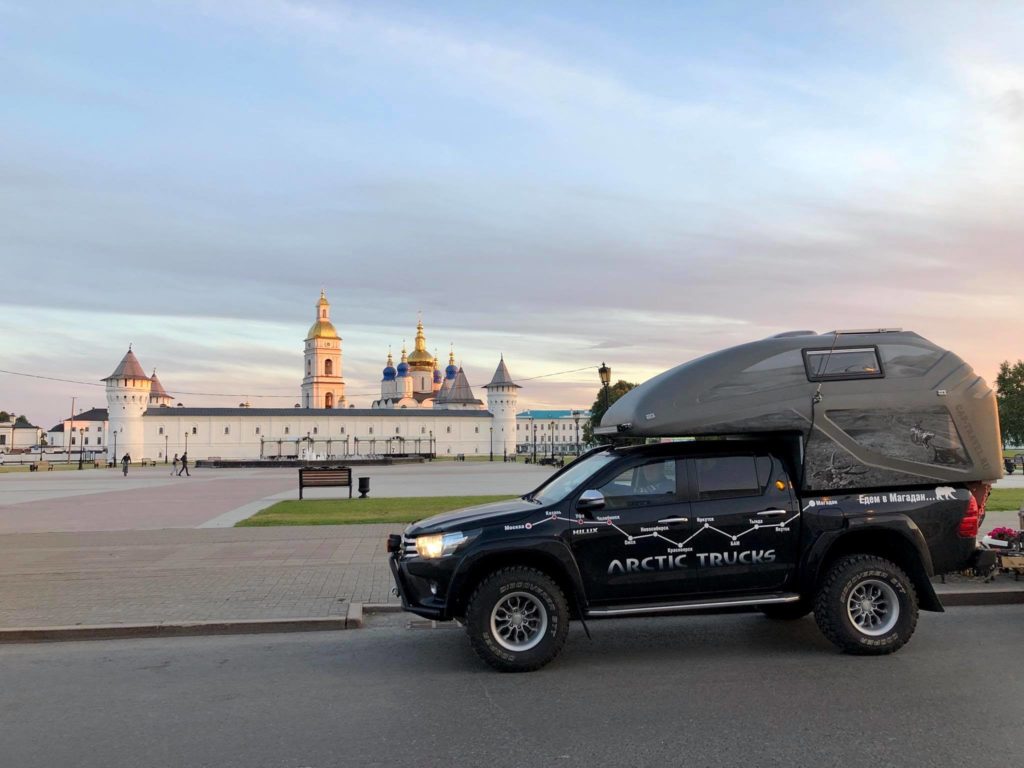
To be more presise, it was the advice of my friend Alexey Anoshko, who we had met by chance in Yekaterinburg. Although we had to drive a few hundred extra kilometers to reach it, we did not regret our decision.
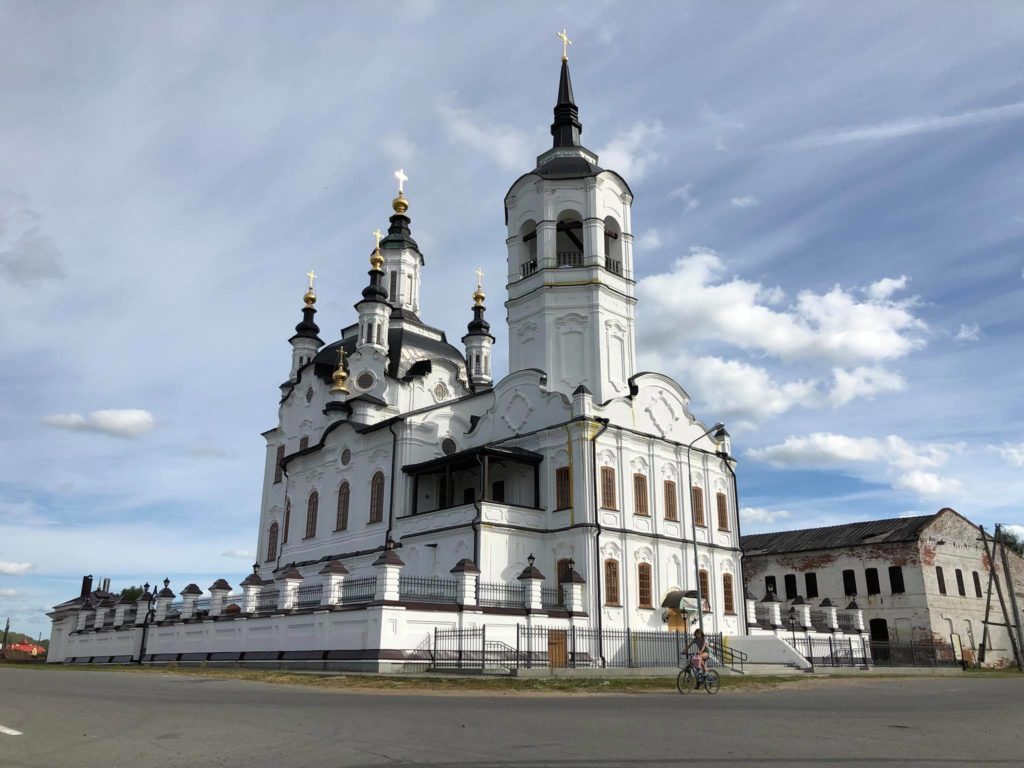
Tobolsk is a unique town with a 450-year history. I would say, a kind of the "Siberian Suzdal". Once it was the capital of the entire Siberian region, which was stretched from the Urals to the Pacific Ocean. Now Tobolsk is a small modern Siberian town with a population of about 100.000 people. However, it is famous not for supermarkets and nightclubs but for its history and the perfectly preserved old part of the town. There you can see a snow-white stone Kremlin, located on the high Trinity Cape, a beautiful St. Sophia Cathedral, two monasteries and a recently restored famous Tobolsk convict prison, which has become a museum. All this is worth it to come here!
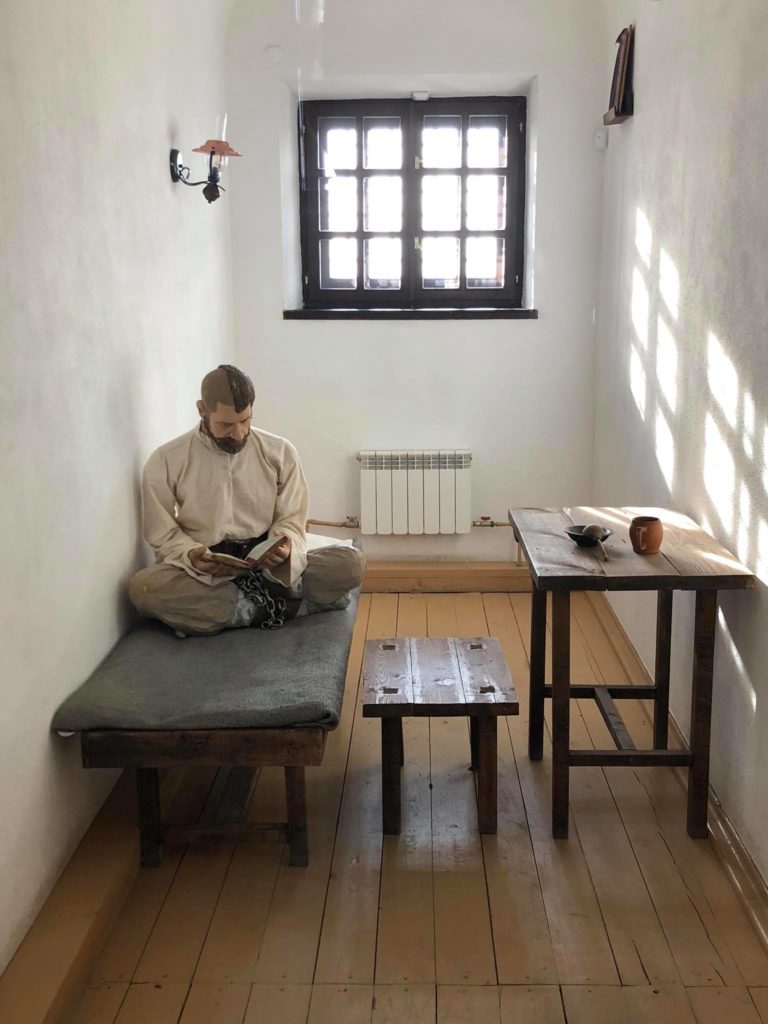
Heading for Magadan.
Tobolsk → Omsk → Novosibirsk.
"And what is the date today?", I asked Oleg.
"I don't know. And why do you need knowing that?"
"Just in case…", was all my answer because I couldn't find the reason why I asked this question. Indeed, does it matter what date and day of the week it is today? This information is absolutely not important in a long journey with no plan, schedule and return ticket. Even the goal is not required.
All we have is the direction of our way. This time we decided to go east until we see the ocean. Then we will make a 180° turn and go back. Magadan is not our goal, it is rather an end point just because there is no further road. :) Our goal is the journey itself.
Every new day is like another episode of an exciting thriller series with yourself in the lead role. Probably, this is the true meaning of life.
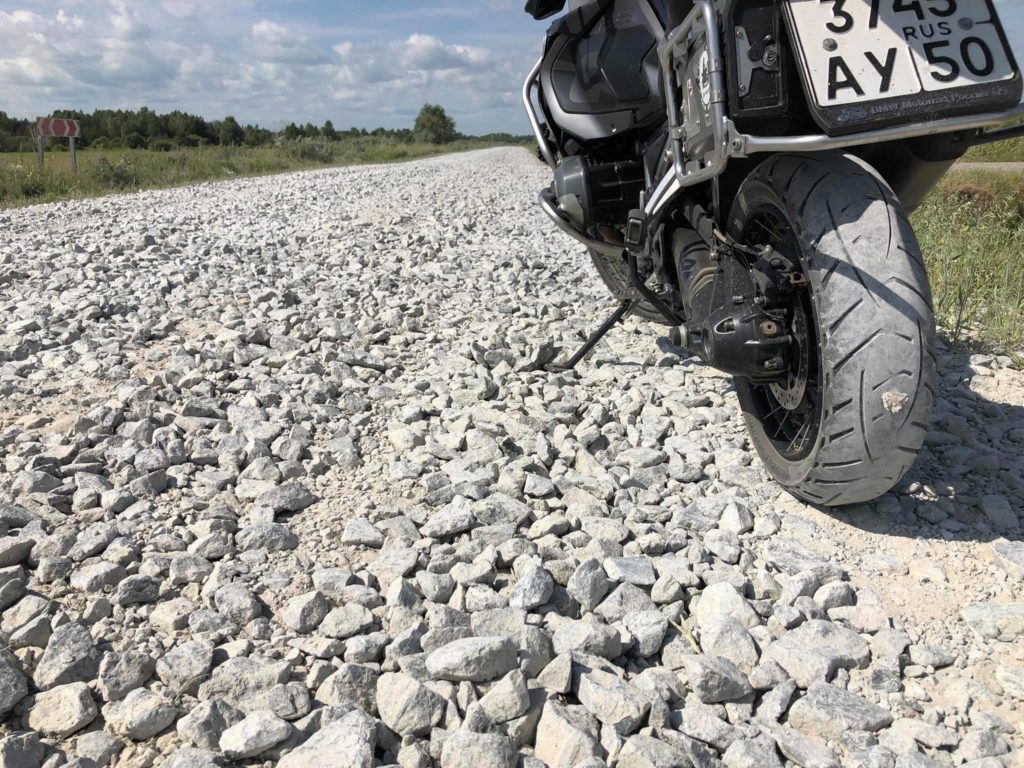
We reached Novosibirsk, the third largest city in Russia, from the side of a huge water basin over the dam of the Novosibirsk hydroelectric power station.

I stopped on the shore of this endless water basin to take a nice picture, but I didn't find an interesting angle. I had only a shot with a lonely fisherman Peter, who I had talked with about fishing before.

Novosibirsk is rather a young city. It is a little over a hundred years old, so there is no historical part and, in general, it did not seem very interesting to me. There's no zest in it. After riding over a huge bridge across the Ob, I found myself in Lenin Street.
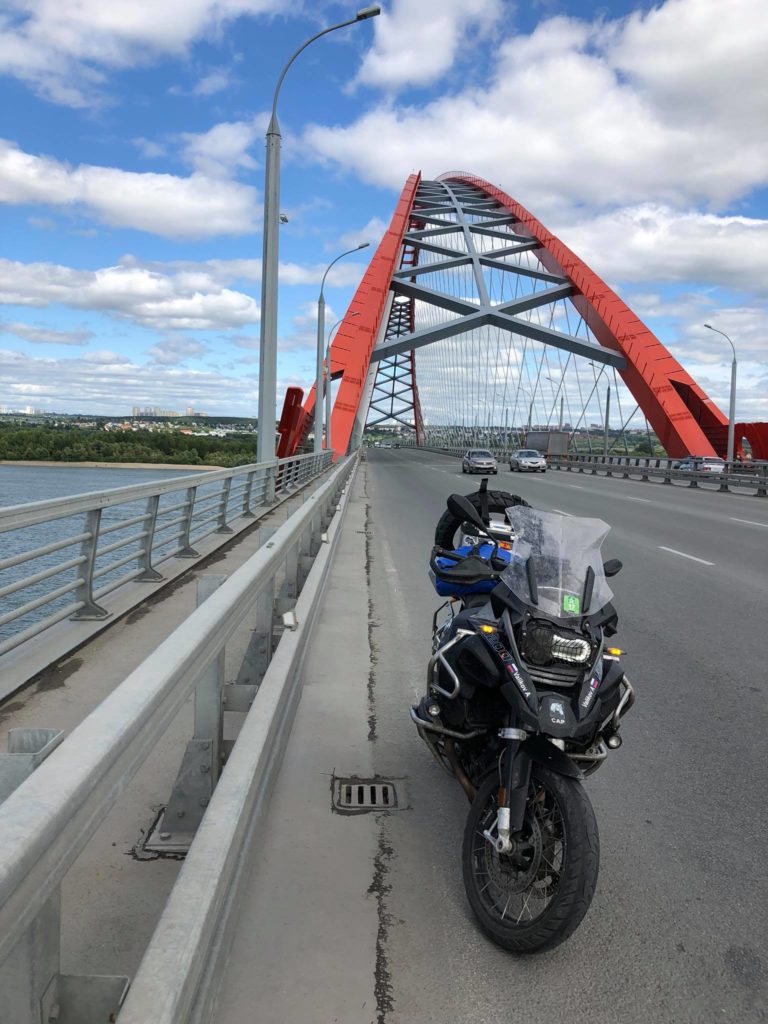
I didn't spot anything remarkable in the centre either (or maybe I was poorly looking for it). But there are a lot of different shops and supermarkets. I found a brand BMW salon and bought some spare rear brake pads (they must be useful in the Kolyma). I also bought a spare tire in another motorbike store and continued my way towards Tomsk, where my friend Vadim, who is a diver btw, was already waiting for us at his lovely cottage with a sauna, a bonfire, barbecue and fine Scotch whiskey!
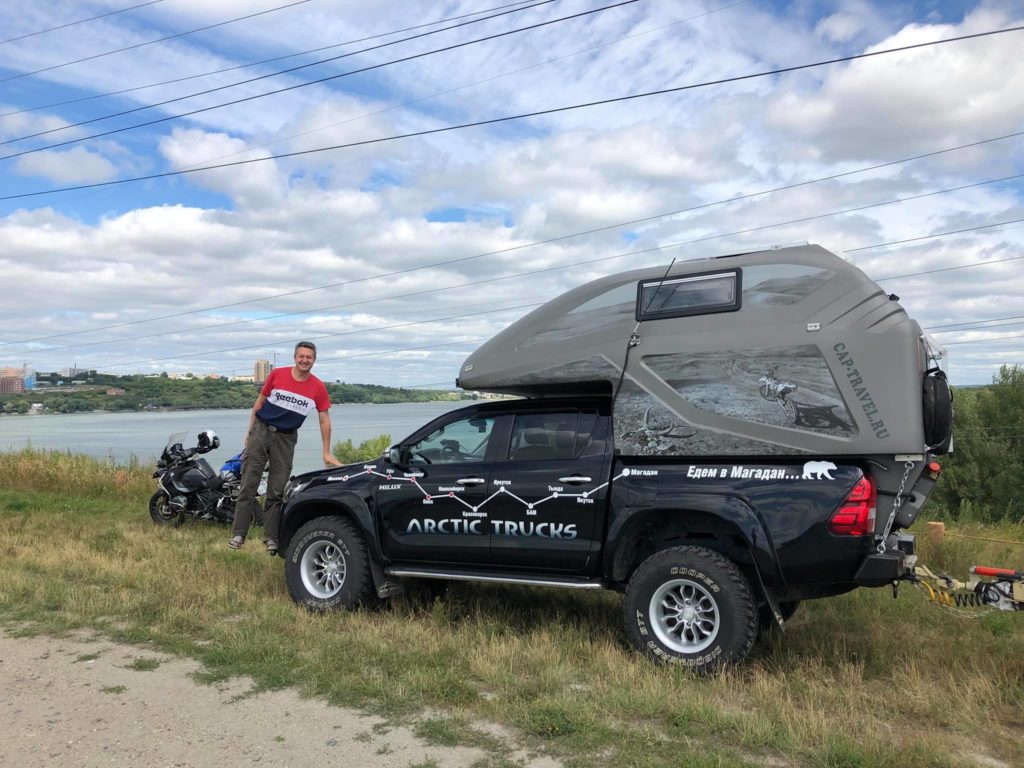
Heading for Magadan.
Tomsk. We had a two-hour morning walk around the central part of the town. This video is about my frst impression of it.
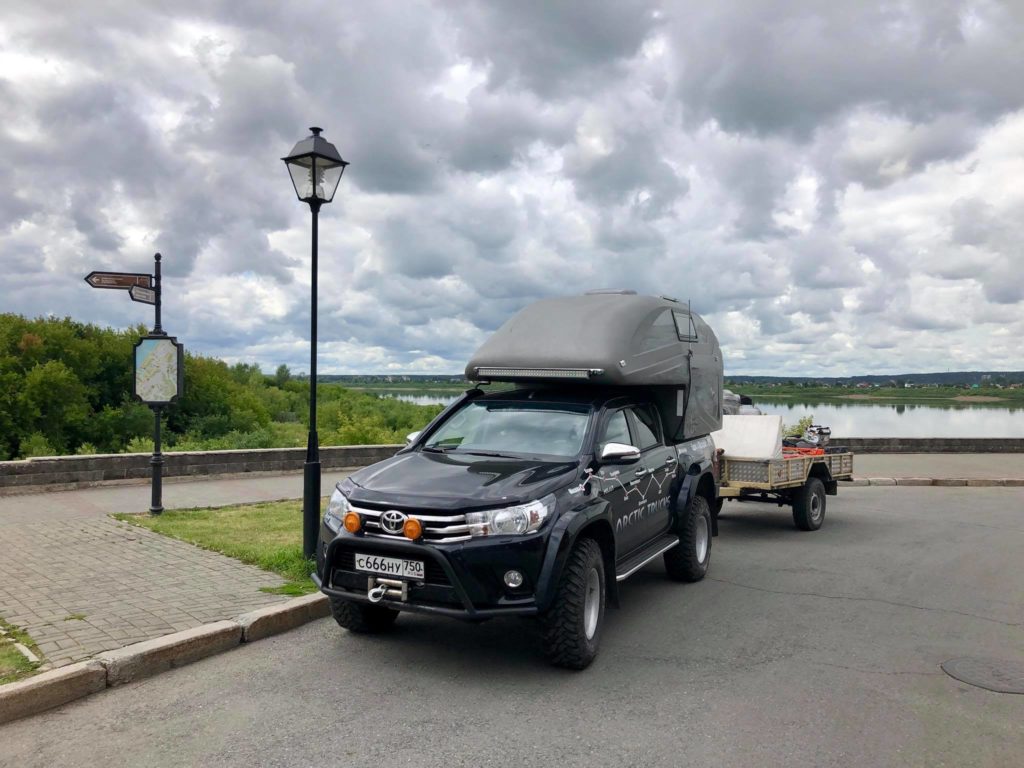
Heading for Magadan.
There is a small town named Achinsk 150 kilometres from Krasnoyarsk. While going along the P-255 highway and there were still a few kilometers to it left, the first thing I saw were huge grey rocks and smoking pipes of the alumina plant (part of Oleg Deripaska's Rusal holding).
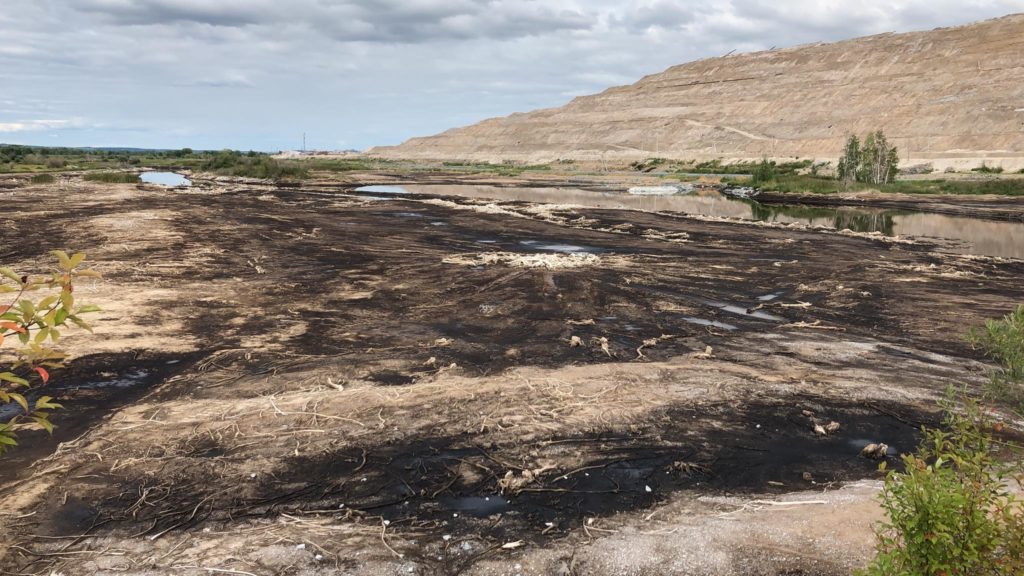
After crossing the bridge over the Chulym river, I slowed down and began to look for a road leading to these mountains, which consist of the waste of mining. I found a narrow path overgrown with grass, turned onto it and rode almost right to the landfills until I ran into a stone obstacle with a signmark "Danger zone. Entry is prohibited."

The view was depressing. I saw mountains of grey rocks and a lifeless desert around. Black puddles (probably, some fuel oil)
appeared through the cracked earth. The smoking pipes of the plant were seen in a certain distance. Trees and even grass will never grow here again. That's a very sad sight.
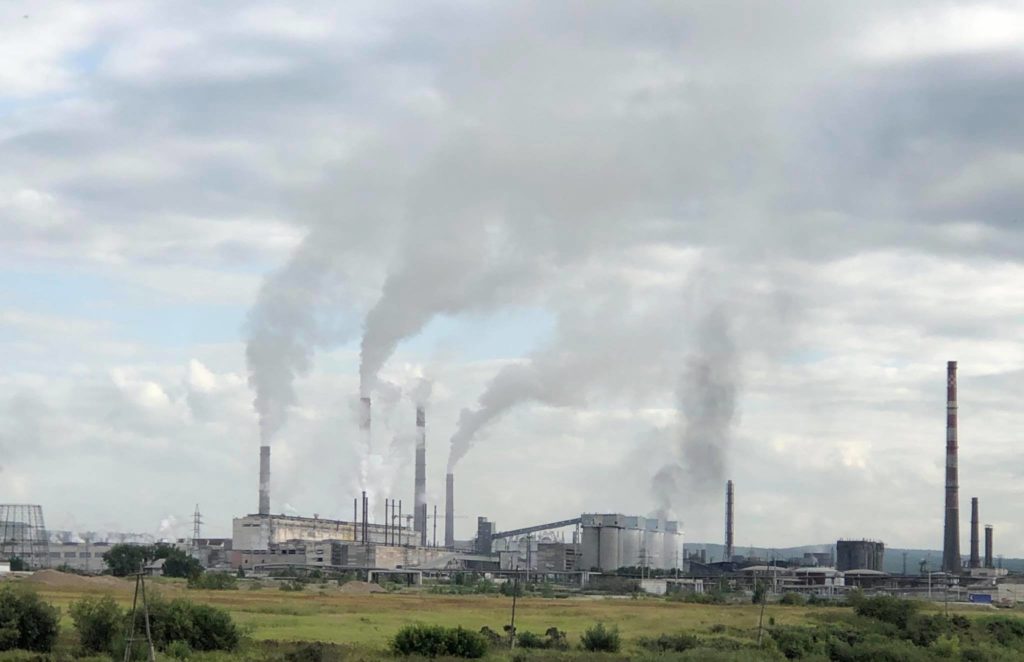
I have already ridden several thousand kilometres and was so happy to see well-groomed fields, freshly mown hay rolled into large rolls, green meadows and forests… In contrast, after this "landscape" I felt filthy. It was like I got myself into this shit. This is the second time for this trip that I have experienced such negative emotions. Let's see what will my further way be like.
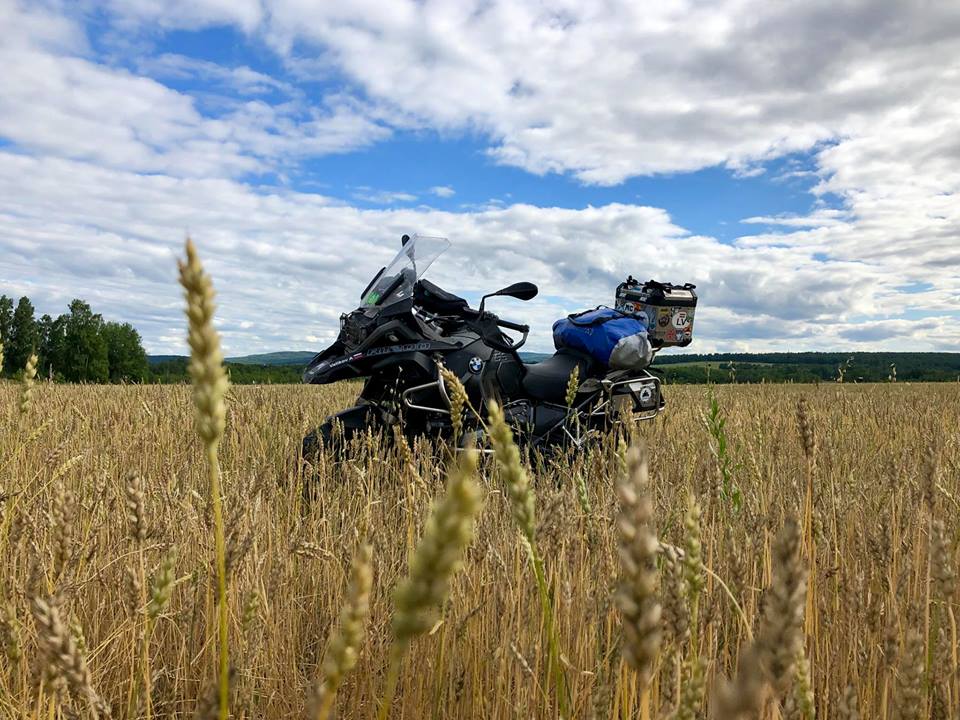
Heading for Magadan.
Krasnoyarsk appeared on my way out of nowhere. The road led up to a high hill, which offered a gorgeous view of the entire huge city, the third largest in Russia. Its territory occupies the whole valley of the Yenisei.
According to the plan, at the beginning of our acquaintance with the capital of the Krasnoyarsk region, we were to visit a famous reserve "The Krasnoyarsk Pillars", located a few kilometers from the city suburbs. It's a unique place that is well-known not only in Russia, but also far beyond its borders.
Foreign tourists come here on purposeto walk along narrow paths, winding through the virgin forests of taiga, and see the giant rocks of bizarre shape, which are scattered in a chaotic manner. Each of these pillars-rocks has its own name, for example, "Grandfather", "Grandmother", "Granddaughter", "Elephant", "Mushroom", etc.
Some of the rocks are conquered only by experienced climbers with an appropriate equipment, others can be climbed by any tourist. There are a lot of animals, which are not afraid of people: squirrels take nuts right out of our hands. The guards said that they had seen a bear with a bear cub a month before, therefore, you can come across signmarks "Beware of bears!"
The next place of interest that we explored was the Krasnoyarsk hydroelectric power station, which is one of the largest structures in our country. You can't get very close to it, but even from a distance of several hundred meters it makes an unforgettable impression!

Having walked along the embankment in the centre of Krasnoyarsk and admired the views of the Yenisei, we went further, to Irkutsk.
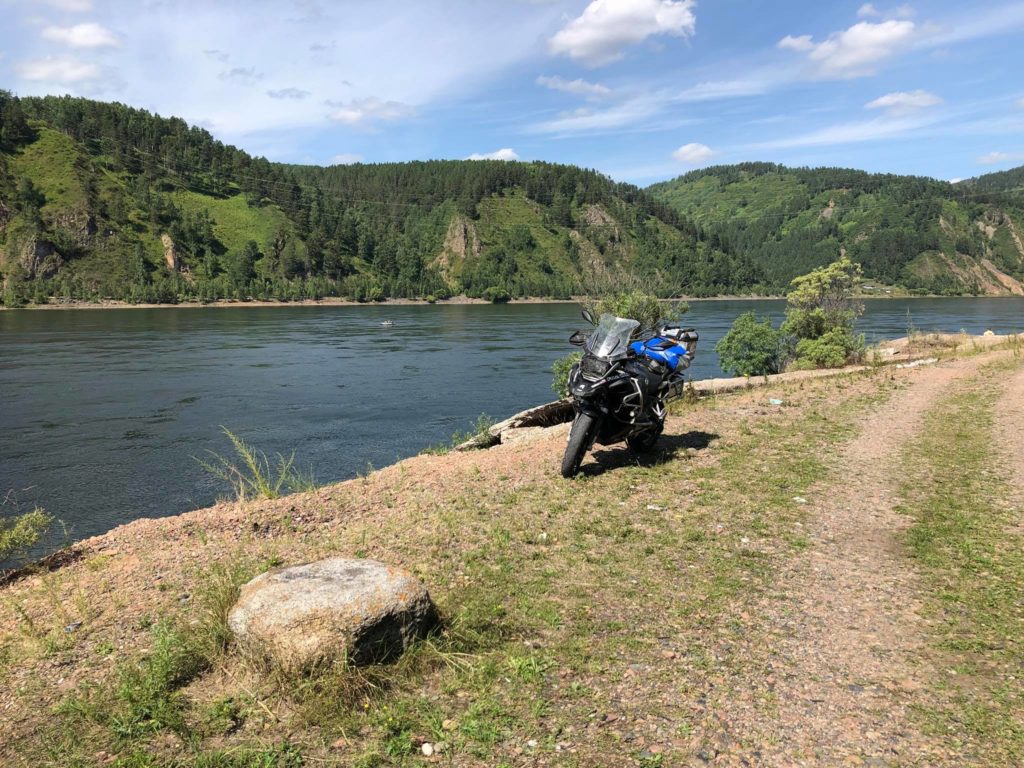
Heading for Magadan.
There are 1060 km from Krasnoyarsk to Irkutsk (from the capital of one region to the capital of the neighboring one). Yes, this is Siberia! The distance isn't as short as the one from Moscow to Tula or the one from Ryazan to Tambov. :)
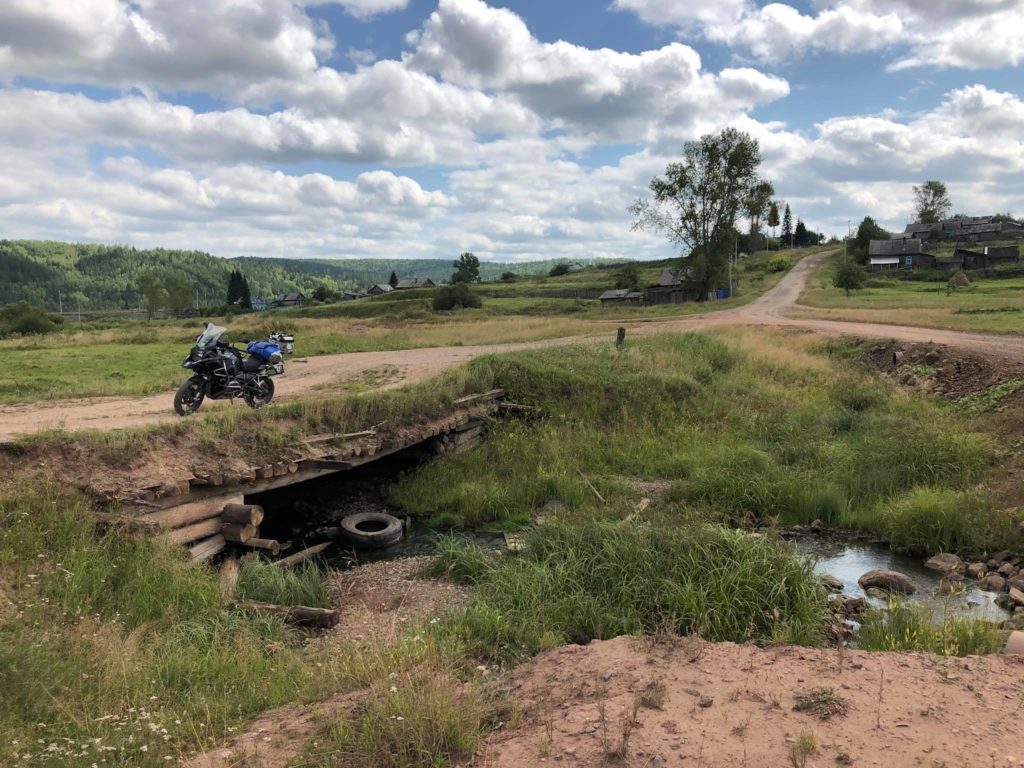
There are solid forests of taiga, and only occasionally you can come across roads leading to the right and left with signmarks of villages and settlements. Siberia is the place where you can immerse into the real wilderness! I made stops by a couple of villages and talked to the locals. This is a guy going with a yoke on his shoulders, carrying water from a well. Near each house there are large wood piles (because stoves are heated with firewood). Coal is said to be expensive. Many people pick berries, sell them at the roadside and make their living by doing it. There is a railway nearby and those, who are lucky and aren't addicted to alcohol, work in it.
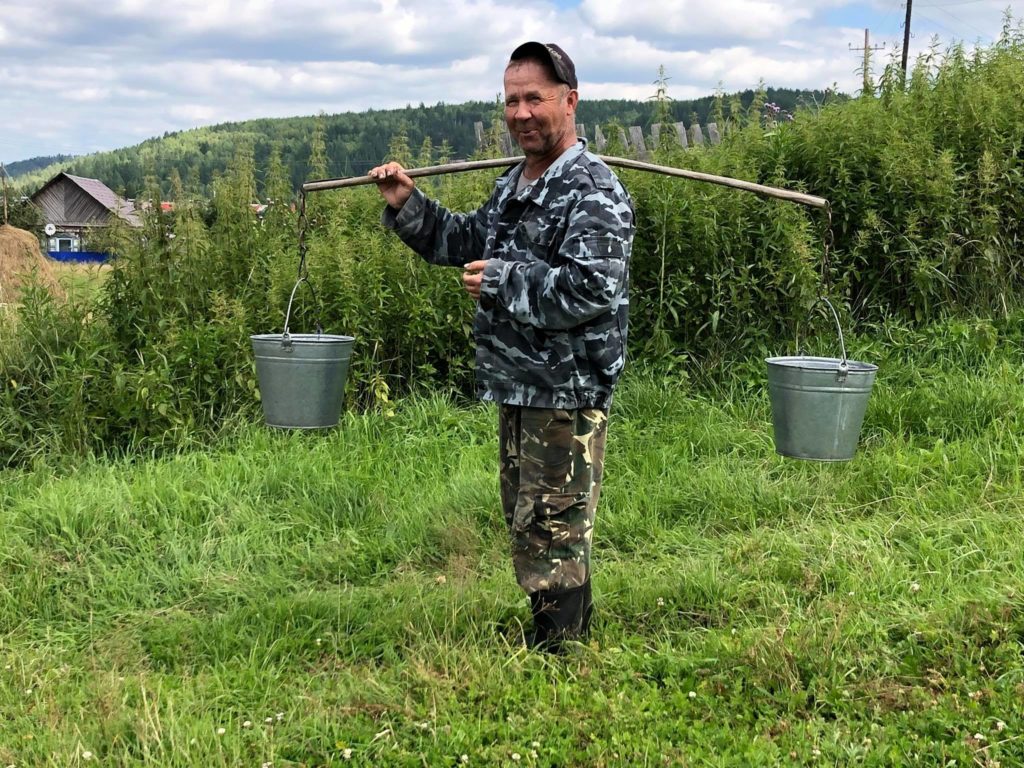
I arrived in Irkutsk at night. At the same time another traveller came there, but he was returning from Magadan to Moscow after a very long motorbike trip. I'll tell you this story in detail in the following post.
Heading for Magadan.
Probably, it must have happened. But even yesterday it was impossible to imagine that this would happen today, moreover, in a six thousand kilometre distance from home, on the Angara embankment in the Siberian city Irkutsk.
On the 18th of August, 2014 this man set off on his first and only one motorbike trip around the world, which lasted four years. About 200.000 kilometers were overcome, dozens of countries and four continents were visited and all this he did alone, travelling by one motorbike. The majority of ordinarypeople can't even imagine this scope (as, for example, it's impossible to imagine the distance from the Earth to the nearest star).
All this time, from the very first day, I followed his Facebook and his website, reading about his adventures. We communicated via various messengers, but I saw him in real life only today. This amazing, cheerful and unbelievably positive person's name is Oleg Kharitonov. In spite of all the difficulties that he had to experience over these four years (and over the recent few days, while he had been riding from Magadan along the sodden and broken Kolyma highway), he did not look tired or lost. The motorbike was almost crumbling, antifreeze was leaking and Oleg still had about 6000 kms left to go in just a week! He had planned to finish on the 18th of August in Moscow.
Good luck to you, Oleg! And I'm already going to the place that you have just returned from. I hope that in the future our paths will cross more than once! All in all, our planet isn't that big and there are not so many roads, along which a little bit crazy people travel either!
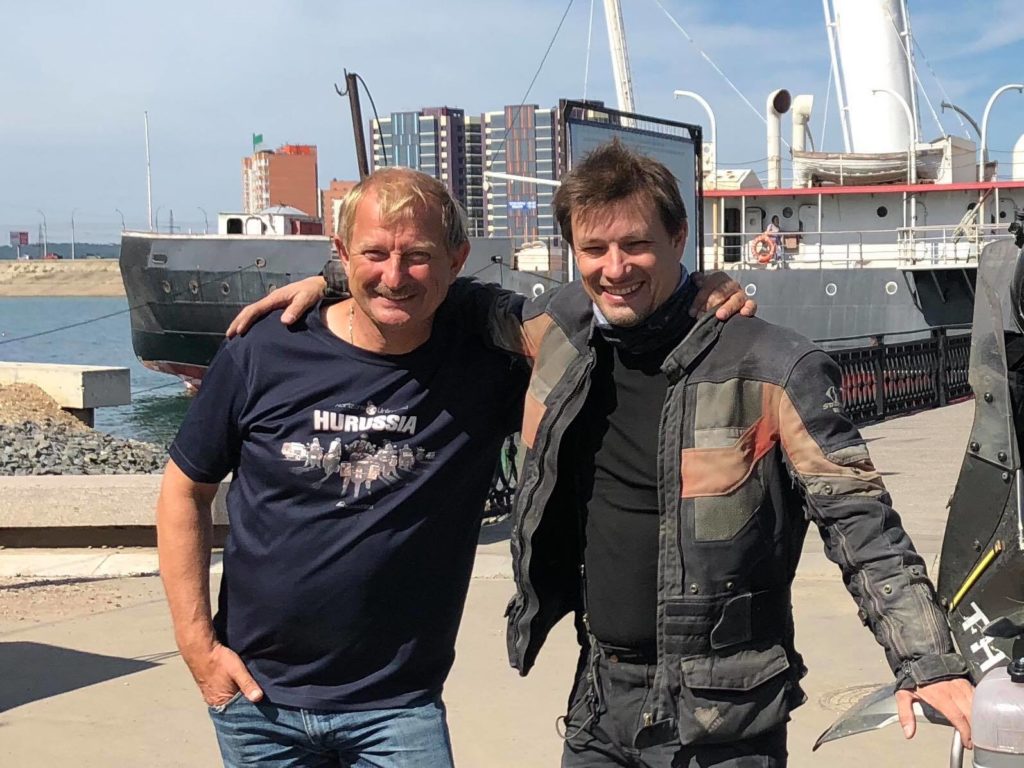
Heading for Magadan.
There are about 250 km of relatively good asphalt road from Irkutsk to the town Kachug. There is one problem: a lot of horses and cows go out on the road, so it's dangerous to drive in the dark. Once a bull jumped right into my lane from behind a standing KAMAZ. I was riding at a speed of about 100 km/h and barely dodged.

Having stayed overnight in Kachuga, we continued our way in the morning. The next village named Zhigalovo was 140 km away, including 120 km of good grader roads. You can go at a speed of about 100 km/h.
There is an interesting place in a 10 km distance from Kachuga, in which you can see the rock carvings that are several thousand years old. I stopped, climbed the rock, looked at ancient images of animals and people and noticed inscriptions of a later period next to them (there were actually more the latter ones, for example, "Vasya was here").
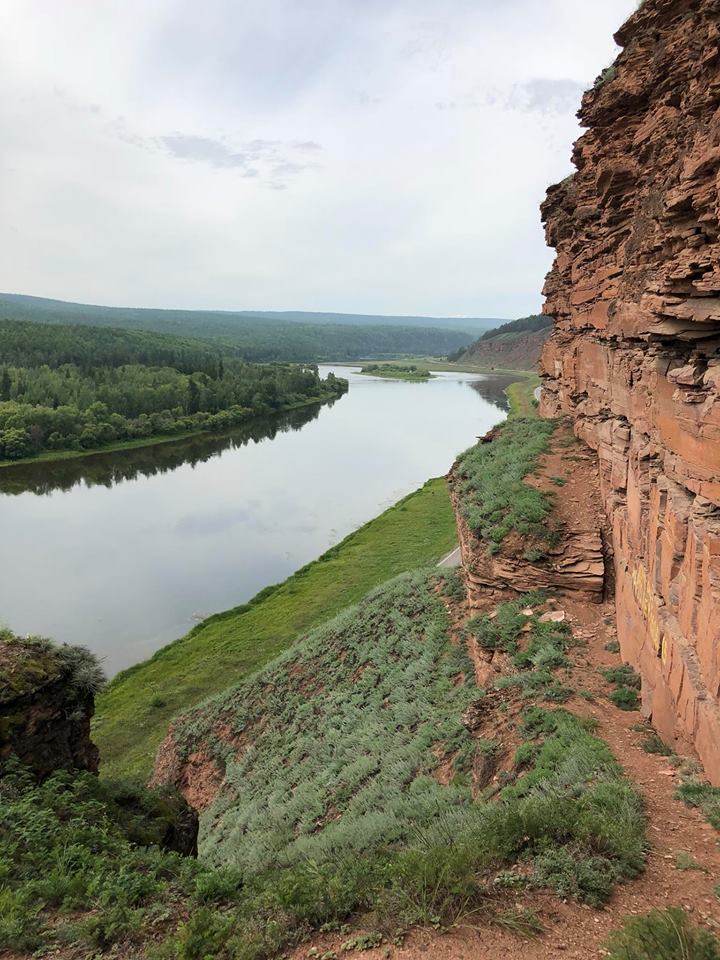
The views were very beautiful: the Lena river, the rocks and the road.
There were many abandoned villages along the way. I stopped at one of them with the simple name Kozlovo and counted there only five yards. All are deserted, the shutters are boarded up, people live only in one of them. A dog barked and a very charismatic man came out. We got acquainted with each other. He told me how he and his wife lived together in an abandoned village. He reminded me a lot of Holy father Anatoly (starring Peter Mamonov) from the movie "Island". There are many such God-forsaken places in Siberia.
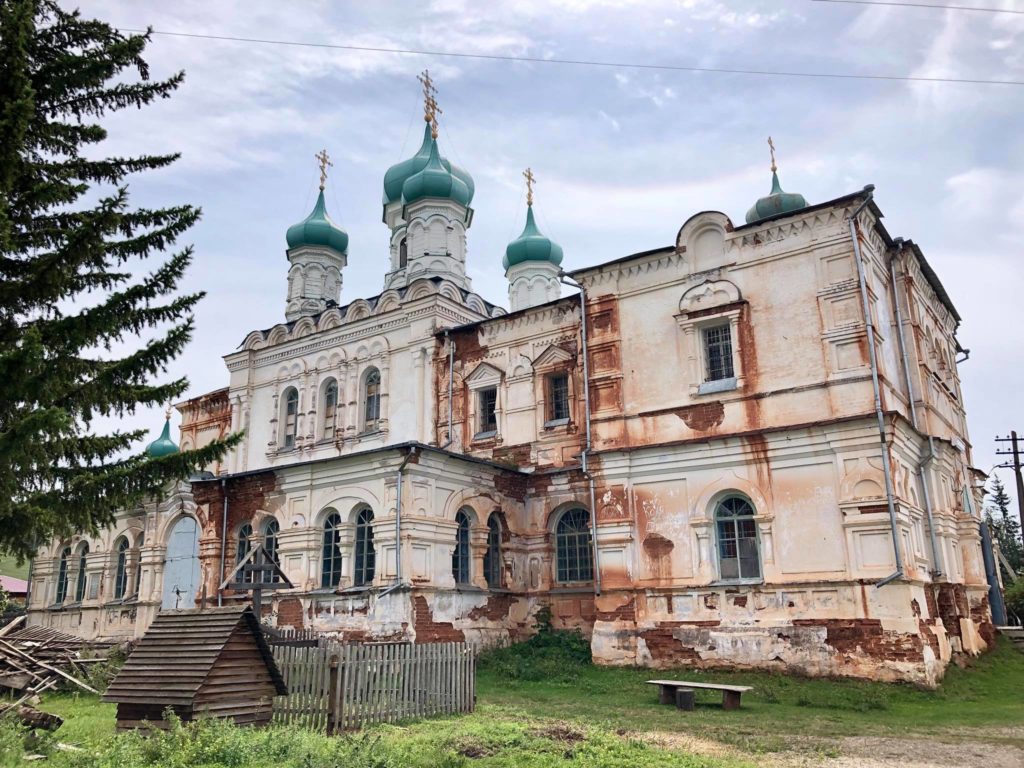
Heading for Magadan.
The way from Zhigalovo to Severobaikalsk was an adventure! It's been a long time since I've ridden along such tracks! It was 440 km long and only 20 km were paved with asphalt. The rest were either grader roads or true off-road ones with pits, rocks and other surprises (about 200 km long). I was incredibly lucky that I had no breakdowns or punctures of tires.
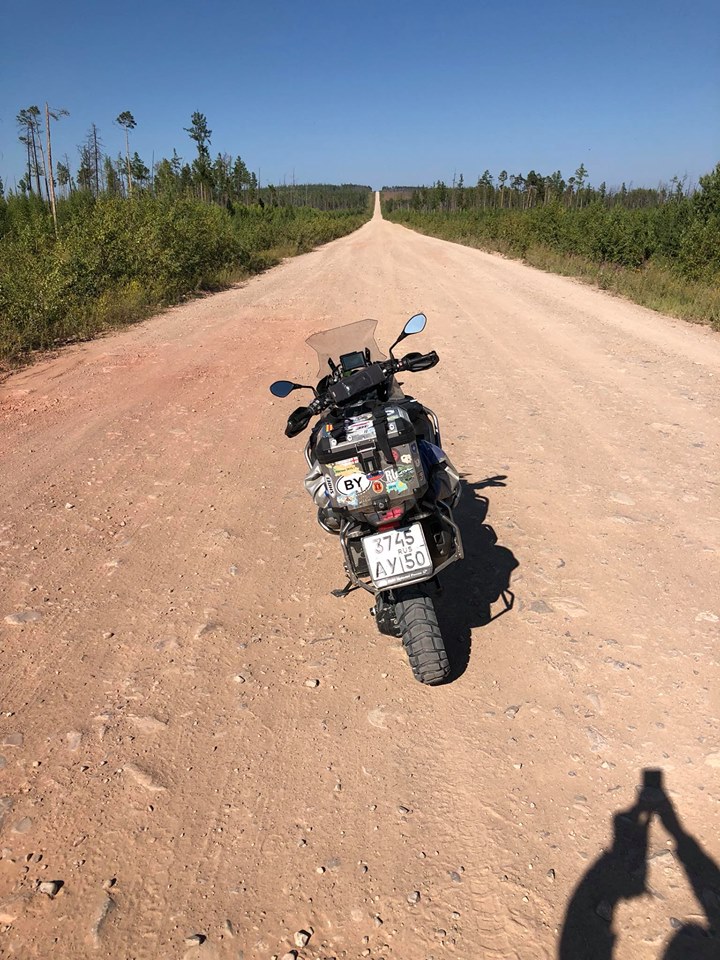
The whole road looked like a battlefield: torn tires were lying along the roadsides, logging trucks were parked there too (their wheels were being sorted). There was such dust that nothing could be seen at a distance 300…400 metres if you rode behind the truck. Every overtaking turned into a super extreme maneuver.
I didn't manage to reach Severobaikalsk that day. It got dark, and riding at night along this road of death could be considered as a suicide attempt.
The final destination of that day was Ulkan, a village situated by the Baikal-Amur Mainline. My search for the hotel didn't make any success. They simply do not exist there. I had to go to the open prison, following the advice of the girl that I had met at the petrol station. There I negotiated on staying overnight in the territory of the corrective colony. For one thousand roubles I was provided with an apartment, including the kitchen, bathroom and washing machine.

Heading for Magadan.
This is the dawn on Lake Baikal.
In Ulkan the guys on the Toyota Land Cruiser 100, who had left Moscow a week later, caught up with us. We were going further to Magadan together.
We went another 130 km distance along the collapsed grader road and finally arrived in Severobaikalsk, the capital of the Buryat section of BAM. This rather big town (according to the local standards) was founded in 1974 on the northern shore of Lake Baikal. The indigenous inhabitants of Severobaikalsk were the first builders of BAM, who had come to the great construction site from all over the USSR and settled there forever.
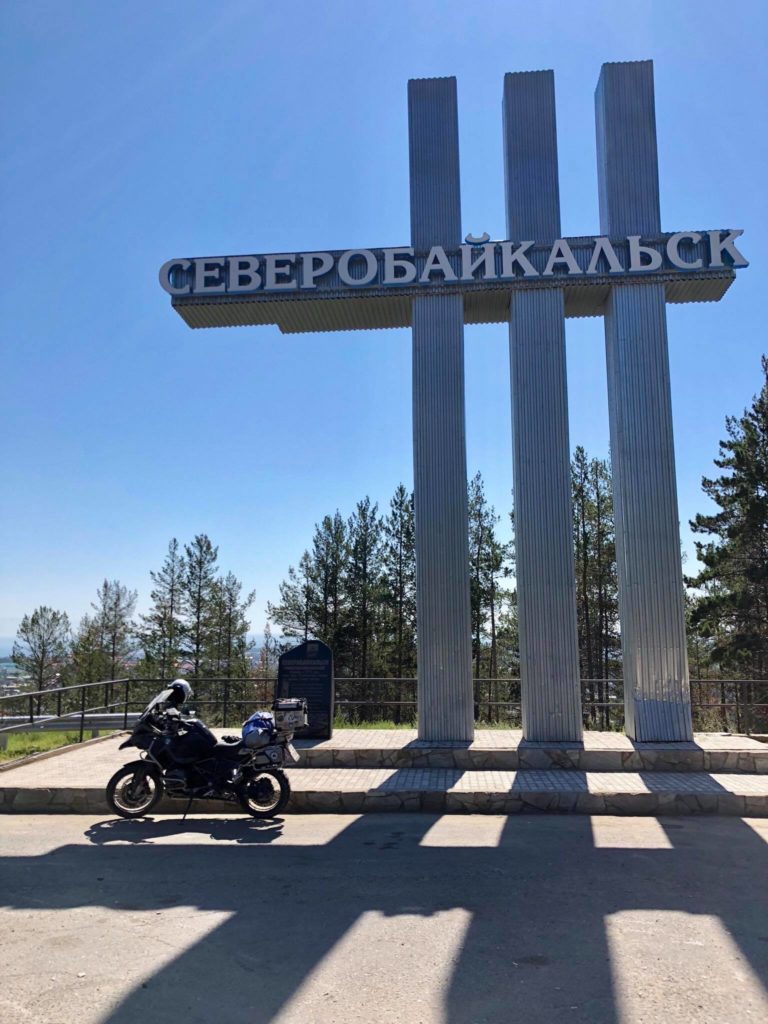
In the 70s the Baikal-Amur Mainline was indeed built by the whole country. The BAM had been declared a priority Komsomol construction site and each of the 15 republics of the USSR was assigned its own section. Tens of thousands of young people went to conquer the taiga, to found new cities and towns and lay the railway through the mountains, gorges and virgin forests.
Some people went as if for a romantic adventure, other ones went in order to earn money. The specialists there were paid 900-1000 roubles (or even more) per month. That was quite a good sum of money for that period! In comparison, the salary of an ordinary engineer at the enterprise was about 150 roubles. A Zhiguli VAZ 2101 car cost 5200 roubles, a TV-set cost 50…60 roubles, a kilogramme of sausage cost 2 roubles 20 kopecks and a bottle of vodka cost 3 roubles 62 kopecks.
Those were such good old days!

Video
Часть 1 - Подольск-Урал-Сибирь
 Cap-travel.ru
Cap-travel.ru